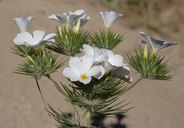Taxon Details
Leptosiphon grandiflorus
large-flowered leptosiphon
View Report Copy Link Calflora eFlora CCH CalPhotos iNaturalist
Taxon Summary:
Leptosiphon grandiflorus, commonly known as large-flowered leptosiphon, is a annual herb in the Polemoniaceae that is found only in California. It occurs within Cismontane woodland, Closed-cone coniferous forest, Coastal bluff scrub, Coastal dunes, Coastal prairie, Coastal scrub, and Valley and foothill grassland, growing at elevations from 5 to 1220 meters. Leptosiphon grandiflorus is ranked 4.2, Plants of Limited Distribution, A Watch List; Moderately threatened in California.|
Scientific Name: Leptosiphon grandiflorus Benth. |
||
|
Common Name: large-flowered leptosiphon |
||
| Family: | Polemoniaceae | |
| Element Code: | PDPLM090K0 | |
| USDA Plants Symbol: | LEGR23 | |
|
Synonyms/Other Names: |
||
| Name Status: |
JEF, FNA, POWO, IPNI, Tropicos |
|
| CA Rare Plant Rank: | 4.2 |
| Fed List: | None |
| State List: | None |
| Global Rank: | G3G4 |
|
State Rank: |
S3S4 |
| Other Status: | |
|
CRPR Changes: |
|
| Add Date: | 1994-01-01 |
| Date Edited: | 2022-01-05 |
| Lifeform: annual herb | ||||||||||||||
Blooming Period: Apr-Aug
|
||||||||||||||
|
Elevation:
5 - 1220 meters 15 - 4005 feet |
||||||||||||||
General Habitats:
|
||||||||||||||
| Microhabitat Details: | ||||||||||||||
Microhabitat:
|
||||||||||||||
| Threat List Total: | 0 | |
| Total EOs | % of EOs | |
| EOs with Threat Listed: | 0 | 0 % |
| THREAT LIST: | ||
|---|---|---|
| Total Occurrences: | 0 | ||||
| Element Occurrence Ranks: | |||||
|---|---|---|---|---|---|
| A | B | C | D | X | U |
| 0 | 0 | 0 | 0 | 0 | 0 |
| Occurrence Status: | |||||
|---|---|---|---|---|---|
| Historical >20 Years | 0 | ||||
| Recent <=20 Years | 0 | ||||
| Presence: | |||||
|---|---|---|---|---|---|
| Presumed Extant | 0 | ||||
| Possibly Extirpated | 0 | ||||
| Presumed Extirpated | 0 | ||||
| California Endemic: | |||||||||||||
| California Island: | |||||||||||||
|
States: Name (Code) California (CA) |
|||||||||||||
|
California Counties and Islands: Name (Code) Alameda (ALA), Contra Costa (CCA), Humboldt (HUM), Kern (KRN), Lake (LAK), Marin (MRN), Mendocino (MEN), Merced (MER), Mono (MNO), Monterey (MNT), San Benito (SBT), San Diego (SDG), San Francisco (SFO), San Luis Obispo (SLO), San Mateo (SMT), Santa Barbara (SBA)*, Santa Clara (SCL), Santa Cruz (SCR), Sonoma (SON), Stanislaus (STA) |
|||||||||||||
|
Quads: Name (Quad Code) Arroyo Grande NE (3512025), Boucher Hill (3311638), Carmel Valley (3612146), Casmalia (3412075), Cerro Colorado (3612068), Chittenden (3612185), Chualar (3612155), Clayton (3712188), Cupertino (3712231), Delta Ranch (3712016), Drakes Bay (3812218), Gilroy (3712115), Gosford (3511931), Gustine (3712038), Hayward (3712261), Hoopa (4112316), Inverness (3812217), Isabel Valley (3712135), La Honda (3712233), Las Trampas Ridge (3712271), Laurel (3712118), Lick Observatory (3712136), Loma Prieta (3712117), Marina (3612167), Mariposa Peak (3612182), Mesa Grande (3311627), Mississippi Creek (3712124), Monterey (3612158), Morgan Hill (3712126), Mt. Day (3712146), Mt. Madonna (3712116), Mt. Sizer (3712125), Mustang Peak (3712123), Oakland East (3712272), Oakland West (3712273), Orcutt (3412074), Pacheco Pass (3712112), Palo Escrito Peak (3612144), Palomar Observatory (3311637), Rana Creek (3612145), Richmond (3712283), Rodriquez Mtn. (3311628), San Francisco North (3712274), San Francisco South (3712264), San Jose West (3712138), San Luis Obispo (3512036), San Luis Rey (3311723), San Pasqual (3311618), San Rafael (3712285), Santa Cruz (3612281), Santa Maria (3412084), Santa Teresa Hills (3712127), Seaside (3612157), Soberanes Point (3612148), Soquel (3612188), Spreckels (3612156), Tomales (3812228), Valley Ford (3812238), Walnut Creek (3712281), Watsonville East (3612186), Whispering Pines (3812276), Willits (3912343) |
|||||||||||||
Notes:
|
|||||||||||||
 Presumed Extant
Presumed Extant
Click on quad for name. Hold Shift Key to use mouse scroll wheel



